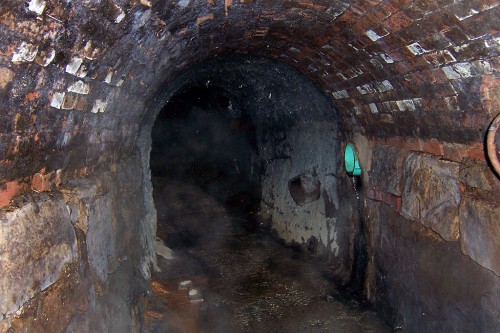 “Is it part of the Underground Railroad?” is the question that comes up every time someone encounters a below-ground structure in the older parts of Cape. Not being a historian, but being a guy who has wielded a shovel in Cape Girardeau and tried to cut through rocks and roots, I’m going to say, “Nope.”
“Is it part of the Underground Railroad?” is the question that comes up every time someone encounters a below-ground structure in the older parts of Cape. Not being a historian, but being a guy who has wielded a shovel in Cape Girardeau and tried to cut through rocks and roots, I’m going to say, “Nope.”
The labor and logistics of moving rock and dirt would be greater than frugal Cape Girardeans would consider expending to move escaped slaves up north. Still, there ARE interesting things under beneath our feet in the city.
Richard Cochran explorations
Here is an email I received from Richard Cochran, Jr., Class of ’84.:
I am very appreciative of the work you put in on your site about Cape Girardeau. I still am fascinated by the history in the city. Many of the articles are before my time (Central Graduate of 84); but, I can relate and have seen many of the items you photograph and discuss.
Longview (Thilenius House)
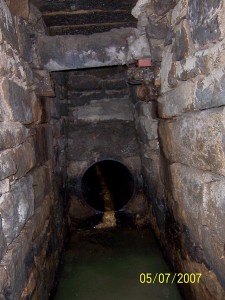 The Thilenius House Wine Cellar and other wine cellar stories are of particular interest. I have some first hand knowledge of the colonial house mentioned in the Thilenius House article as I was working for my father when that home was designed. I helped draft the house plans. I particularly remember surveying the site and examining the wine cellar when we started that project.
The Thilenius House Wine Cellar and other wine cellar stories are of particular interest. I have some first hand knowledge of the colonial house mentioned in the Thilenius House article as I was working for my father when that home was designed. I helped draft the house plans. I particularly remember surveying the site and examining the wine cellar when we started that project.
The newer home which was built by an Indian doctor in the mid 80’s was located behind the cellar. I remember his purchase of the property required that the cellar not be damaged. I also remember that the house had one room designed around a particular piece of furniture that he had which was an odd dimension not fitting in most normal rooms. I think he sold the house since then; but, not positive.
I’m not sure if the cellar still exists; but, it seems that the last time I drove by there, I couldn’t see it anymore.
Sanitary and storm sewers
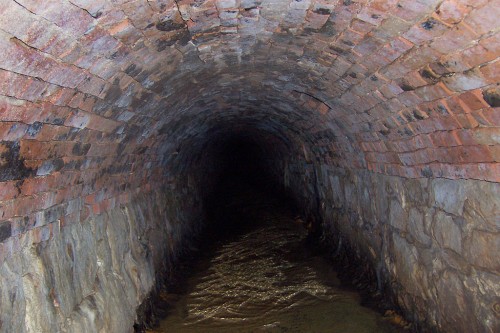 Anyway, to get on with it, I am a Civil Engineer and have worked on some sewer projects in the city. One of these near City Hall got me climbing into manholes to verify things. At one time, the sanitary sewer and storm sewer were combined in this area and flowed through the same pipes/tunnels. It think over time, some of this infrastructure has been replaced and I know in the mid 2000’s, the sanitary was separated from the storm so that it could be treated at the wastewater plant instead of discharged into the river.
Anyway, to get on with it, I am a Civil Engineer and have worked on some sewer projects in the city. One of these near City Hall got me climbing into manholes to verify things. At one time, the sanitary sewer and storm sewer were combined in this area and flowed through the same pipes/tunnels. It think over time, some of this infrastructure has been replaced and I know in the mid 2000’s, the sanitary was separated from the storm so that it could be treated at the wastewater plant instead of discharged into the river.
Stone and brick tunnels
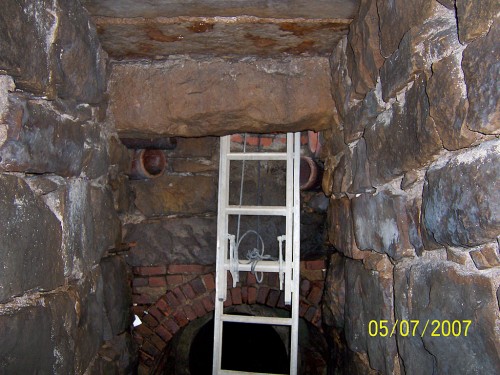 During my inspections, I found older parts of the sewer system which were tunnels. These were constructed of stone and brick in some areas. This piqued my interest as well, wondering when they were constructed and if they possibly served other purposes. I’ve heard the stories all my life of tunnels from homes to the river used by the underground railroad and wondered if possibly, some of these storm tunnels were actually what was used?
During my inspections, I found older parts of the sewer system which were tunnels. These were constructed of stone and brick in some areas. This piqued my interest as well, wondering when they were constructed and if they possibly served other purposes. I’ve heard the stories all my life of tunnels from homes to the river used by the underground railroad and wondered if possibly, some of these storm tunnels were actually what was used?
I’ve attached some photos that I took of these tunnels. They aren’t the best quality; but, you can see the tunnel and where some changes have been made connecting pipes and such.
Cape Sewers in 1940-1941
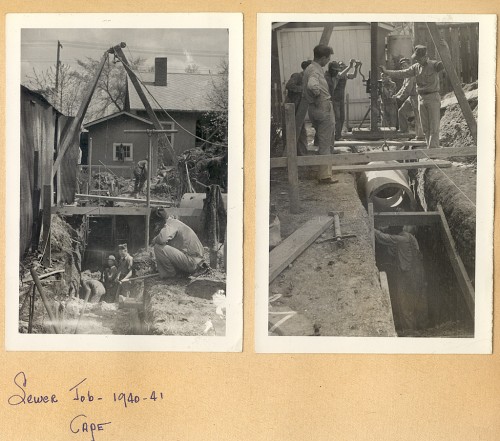 I have one of Dad’s scrapbooks that shows the Cape sewers being constructed in 1940-41. I’ll run more photos soon. The sewers Richard photographed are much older than Dad’s project. Dad’s trenching was done mostly by hand (under conditions that would cause an OSHA heart attack these days), but all of the pipes were precast concrete instead of stone and brick.
I have one of Dad’s scrapbooks that shows the Cape sewers being constructed in 1940-41. I’ll run more photos soon. The sewers Richard photographed are much older than Dad’s project. Dad’s trenching was done mostly by hand (under conditions that would cause an OSHA heart attack these days), but all of the pipes were precast concrete instead of stone and brick.

what wonderful pictures
I remember the old “wine cellar” on Whitener Street, by Longview – got covered up some time ago, it appears – but all of us who lived anywhere nearby when we were kids knew about it, as it was the ultimate dare to go down into the pit. One of the tunnels was caved in and the other was too creepy to go in. Ken, do you have pictures of that? It’s been years since I’ve thought about it.
These are great pictures, by the way, for those of us, like myself, who are self-proclaimed “infrastructure geeks.”
I used to play around the house and wine cellar on Whitener Street. sometimes went into it and was once given a tour by the daughter of the family that lived in the house. It was not really a tunnel, but a large red brick building [north of the house] with the lower part below grade. You could actually walk into the lower section from the west end which had large barn type doors. As I recall[and this is from 1940 something] she told us that the lower area had most recently been used to grow mushrooms. The kids in the area had stories about the house being haunted [I still tell one of those ghost stories] and we believed it had been built before the civil war. She corrected that belief and as I remember, told us the house was built about 5 years after the war. I think there is an historical tablet in front of the house now which gives that information.
During the 40’s the area south of the house, facing Independence St., was a horse pasture surrounded by an electric fence. We kids would play games like joining hands and then one would grab the fence sending a shock wave through the entire group. We didn’t repeat those games or experiments often.
thomas kimmel I was born in 1944. live about 3 blocks from n. sprig st. by the collage 15733354189 give me a call.
I ran across the article in the southeast missiourian today, about the storm drainage work being done. and I looked up storm tunnels in our town. this is so interesting!..;-)
I grew up directly across the street from Longview. At the time, it was owned by the McGowan (sp) family. I remember having to go in the house to tend to their cats and parrot when they went away. That was always a spooky experience for a small kid. I remember once when I went in to feed the cats and parrot, I heard glass breaking upstairs. I went upstairs to investigate (obviously quite scared) and ended up find a bird had broken through a window and was flying around one of the rooms, knocking pictures and knick-knacks off the shelves. That was a relief.
I also remember helping them with chores around the house and hauling lots of yard debris (tree limbs, garden clutter, etc) to dump into the wine cellar. On a couple of occasions, I would sneak down into the wine cellar to investigate. At the time, one of the tunnels was open and you could go several feet into it before it was walled shut. The other tunnel was walled shut at the entrance.
Good times…fond memories.
I am the author of the horror novel; “Tattoo: A Beautiful Sin” and am now writing the next book in what will be a trilogy. The next story takes place in Cape Girardeau, in and around the SEMO campus. I’m going to use the underground tunnel system to help the killer move bodies but don’t have a clear understanding of where all the tunnels run. If anyone has a map, can you please email me at tattooauthor@gmail.com? Thank you so much!
~Kenny Sills (SEMO class of 94′)
Good luck. I’m afraid I don’t have any information other than what I’ve posted.
I used to live in a super old house on park street that had opening to the tunnels in the basement! The house was also seriously haunted like hell!! As a kid that place was horrifying but now I’d love to explore it!
Does anyone know where the openings to the tunnels are on campus? I know one is in the basement of Cheney Hall. That’s how I got in when I was in college there. Thanks!
Hello! I’m not sure if you’re still wondering about the entrances on campus, but I know of at least 4 that are still open and not sealed.
Please share! I only know of two so far. I’ve got a long list of possibilities, but would love to know which are for sure.
i would like to find out more about the tunnels. any links to read about them or where the entrances are?